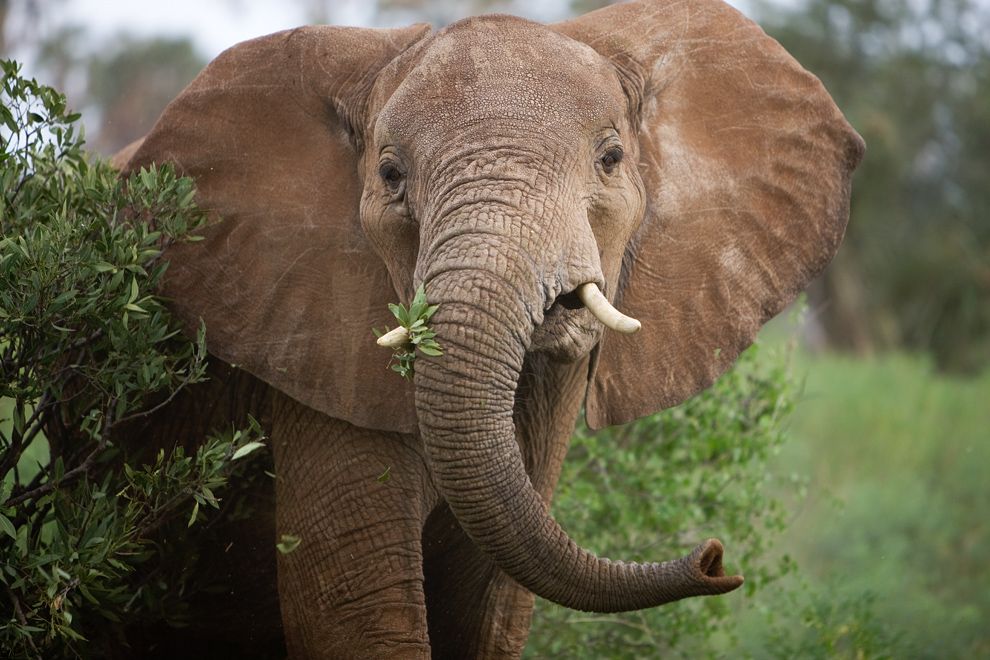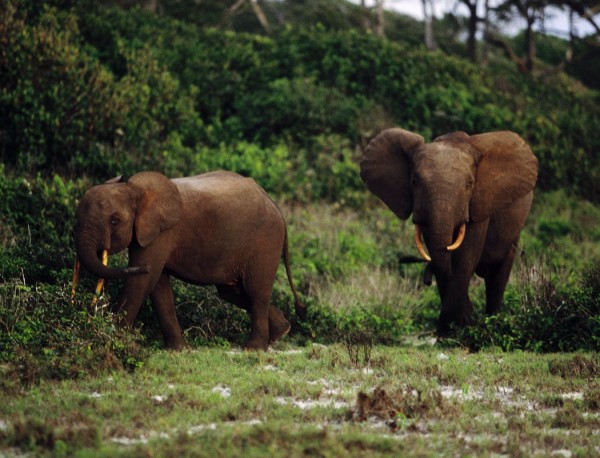Interactions
Loxodonta cyclotis,
the African forest elephant, is considered a necessary part of the
ecosystem that is the forests of Africa, the keystone (Blake et al., 2009).
Without the forest elephant there would be a great decrease in the
diversity of trees. But the forest elephants are continuously at
risk of being hunted and killed for their ivory.
Loxodonta cyclotis have a
mutualistic relationship with the trees surrounding them. This
relationship exists because forest elephants eat trees to sustain
their large body mass and to fuel them in their journeys, while
trees benefit in a slightly less direct way. Trees benefit from
their seeds being eaten by the forest elephant. While in the
elephant's stomach the seeds begin to germinate. This is because the
acidity of the forest elephant’s gut helps in the germination
process of the seed, since nearly all of the seeds that reenter the
world, after being inside the elephant, are ready to sprout into
trees (Beaune, 2013). When the seeds are released from the forest
elephant's body with its dung, having gone through days’ worth of
travel in the elephant’s gut, the seeds are large distances away
from where they were consumed and are ready to grow. It is for this
reason that Loxodonta cyclotis are the largest contributors to the
dispersal of seeds. The larger the seed ingested by the elephant the
longer it takes for the elephant to disgust and the farther away the
seed can be carried by the elephant. The time that a seed remains in
the elephant’s gut is directly related to the size of the seed when
it is ingested. So a smaller seed would take about a day to pass
through an elephant’s system while a large seed could take over
three days before it is released to begin growing (Blake et al., 2009).
Because forest elephants have such large guts they need lots of
nutrients to sustain them, but most of the time they cannot
accomplish obtaining all of this food in one area so they must
travel large distances to these nutrients. This need to obtain food
can cause Loxodonta cyclotis to travel about
 twenty-four miles in a
day (Granli and Poole, 2008). Once a new population of seeds is dispersed by the
African forest elephants the seeds can then grow into a tree and
disperse its own seeds through gravity and wind and being eaten by
small herbivores and omnivores until the elephant comes through
again to carry the seeds away to start another new population far
away (Blake et al., 2009). Within their three day time that their gut can
take to send the seed through, from mouth to tail, an elephant can
travel a maximum of fifty-seven kilometers (Blake et al., 2009). By this
understanding, Loxodonta cyclotis can dispense seeds
farther than any other form of dispersal, making them essential for
the forest to survive.
twenty-four miles in a
day (Granli and Poole, 2008). Once a new population of seeds is dispersed by the
African forest elephants the seeds can then grow into a tree and
disperse its own seeds through gravity and wind and being eaten by
small herbivores and omnivores until the elephant comes through
again to carry the seeds away to start another new population far
away (Blake et al., 2009). Within their three day time that their gut can
take to send the seed through, from mouth to tail, an elephant can
travel a maximum of fifty-seven kilometers (Blake et al., 2009). By this
understanding, Loxodonta cyclotis can dispense seeds
farther than any other form of dispersal, making them essential for
the forest to survive.
Loxodonta cyclotis have a parasitic relationship with humans, well technically the parasitic one is the human. This parasitic relationship exists because humans have been hunting and killing forest elephants, poaching them, to collect their tusks for ivory and the rest of the elephant’s body is used for its meat. Of course neither of these reasons for hunting forest elephants is beneficial to the forest elephants themselves, which is the reason they now have a much smaller population than in the past, making them endangered. Humans are the main threat to the forest elephant's existance because other than Panthera leo 'Lion' and hyenas, who only go after baby elephants, humans are their only preditors (African Forest Elephants, 2008).
It is likely if the poaching
continues not only will the African forest elephants be extinct, but
so will the trees that are helped because of them and the trees that
they maintain, disperse seeds for.